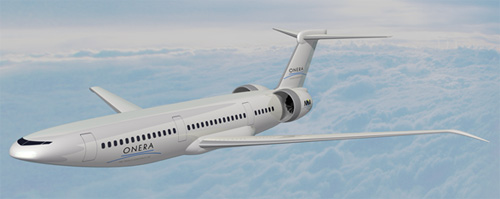French aviation research company Onera released an image this week of the group’s idea for a new, mid-size, mid-haul aircraft. The plane is designed to carry about 180 passengers about 3000 nautical miles (comparable to a 737-900 today) and 20% more fuel efficient than an A320. And it is unlike anything flying in commercial service today. The NOVA – NextGen Onera Versatile Aircraft – concept is aimed for operation around 2030, assuming lots and lots of other things fall in to place.

The design of the aircraft is different from modern commercial aircraft in just about every way possible. The fuselage cross-section is a ovoid rather than a circle and the nose is “raised” relative to the body. The wingtips point down rather than up and the engines – which are both heavier and more efficient than today’s models – are mounted at the tail rather than under the wings. And the engines are “semi-embedded” in the fuselage which allows for higher efficiency, though also plenty of challenges with the boundary layer air ingested alongside the aircraft.
The ultimate goal is a design which is more efficient to operate, even with the unconventional design and added weight. The angle of the nose, for example, adds lift to the plane overall. This comes at the expense of the view angle from the flight deck but the company says that was considered; it certainly doesn’t appear to be as bad as with Concorde. Many of these design decisions result in a plane which requires more internal structural supports and other weight-adding bits, but Onera believes the additional weight can be offset by aerodynamic and engine efficiency. The fuselage cross section would require additional supports which increase weight. The wingtips pointed down are less efficient, for example, but also exert less stress at the fuselage join point. This would reduce weight rather than increase it.
The aircraft would be a twin-aisle design, which adds to passenger comfort and helps with the aerodynamics. It also means things like the increased weight for the cross-sectional supports would not run as far front to back, helping keep the extra weight requirements lower.
All in all it is definitely a new and different design. The part where it seems the designers haven’t considered costs in their effort makes me think this is quite unlikely to ever fly. But it is quite interesting to look at and the specs put it around those needed to be a suitable replacement to the 757s which will be almost certainly retired by 2030.
Never miss another post: Sign up for email alerts and get only the content you want direct to your inbox.



Fascinating. I love creativity and disruptive thinking, though I tend to agree with you that if they haven’t consider costs, this may very we be a non-starter. On a childish note, just gotta say that I snickered a bit at “NOVA.” Reminds me of the marketing Chevy marketing blunder in the U.S. of the car by the same name, which in Spanish is “doesn’t go.” :p
http://blog.seattlepi.com/aerospace/2010/09/24/boeing-patents-design-for-elliptical-two-aisle-narrow-body/
Not only boundary layer issues with the body of the plane, but the uneven intake would create all sorts of issues with the airflow within the engines. I spend my work days examining airplane engine patents, so I would like to think I have a pretty good grasp on the technology, and I sure wouldn’t want to be the guy tasked with designing the internals for that.